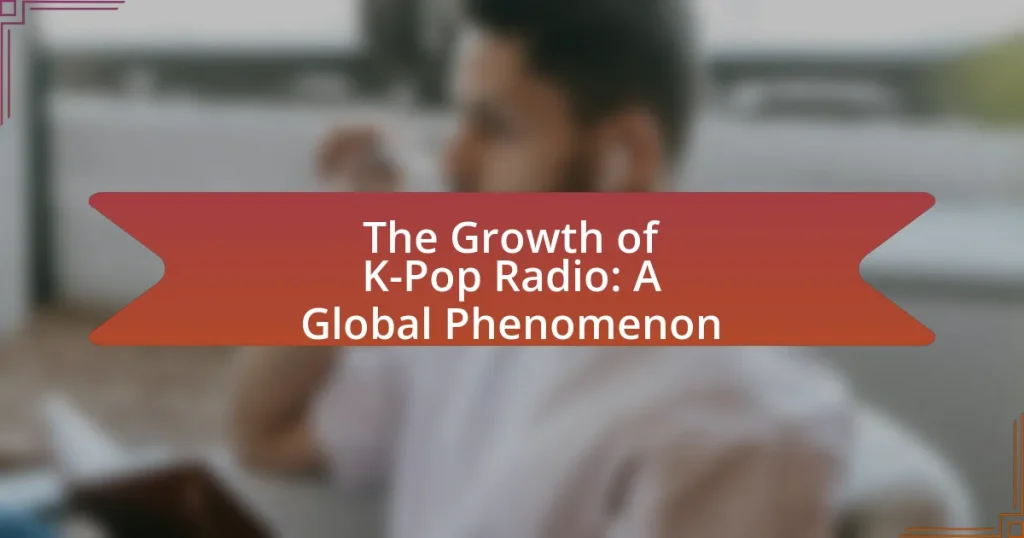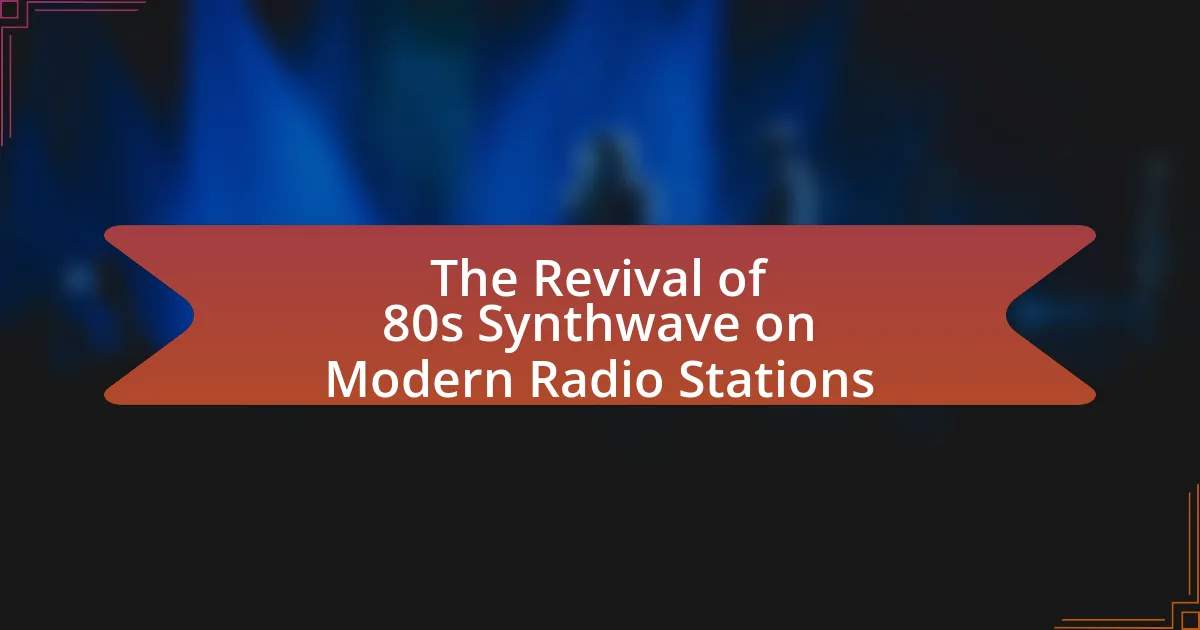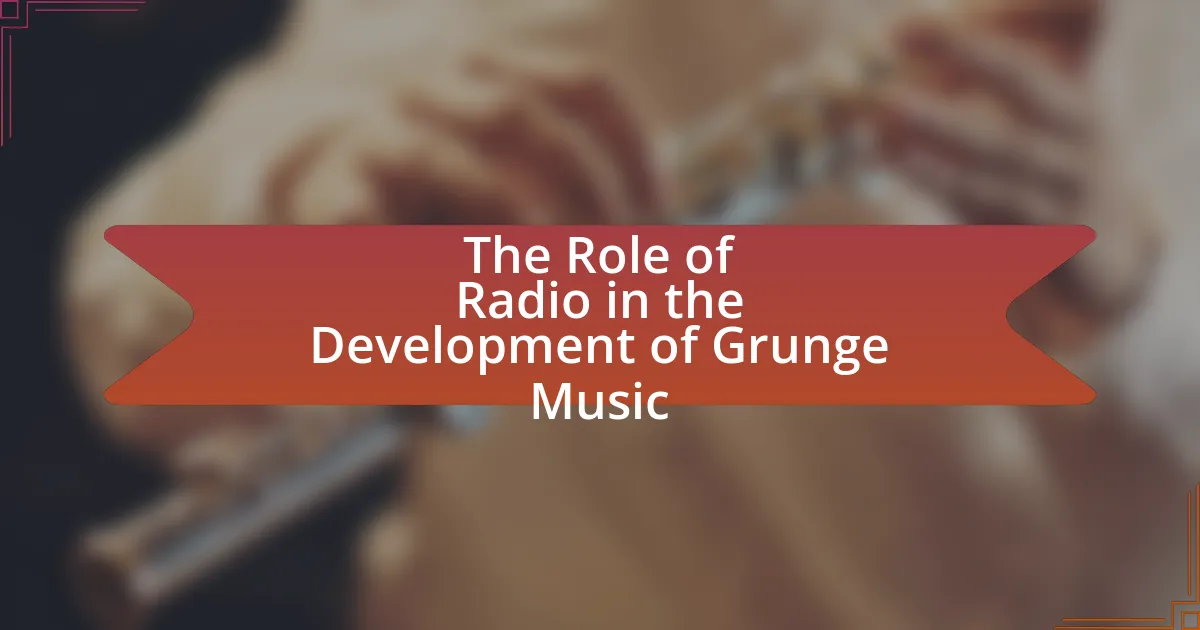The article examines the significant growth of K-Pop radio, highlighting its expansion from South Korea to a global audience, particularly in North America, Europe, and Southeast Asia. It details the evolution of K-Pop radio over the years, driven by technological advancements and the rise of streaming platforms like Spotify and Apple Music, which have facilitated international access to K-Pop music. Key milestones, such as the establishment of dedicated K-Pop radio stations and the integration of K-Pop into mainstream playlists, are discussed, along with the role of social media in promoting K-Pop radio. The article also addresses challenges faced by K-Pop radio stations in the global market and explores future trends, including the integration of AI and potential collaborations to enhance growth.
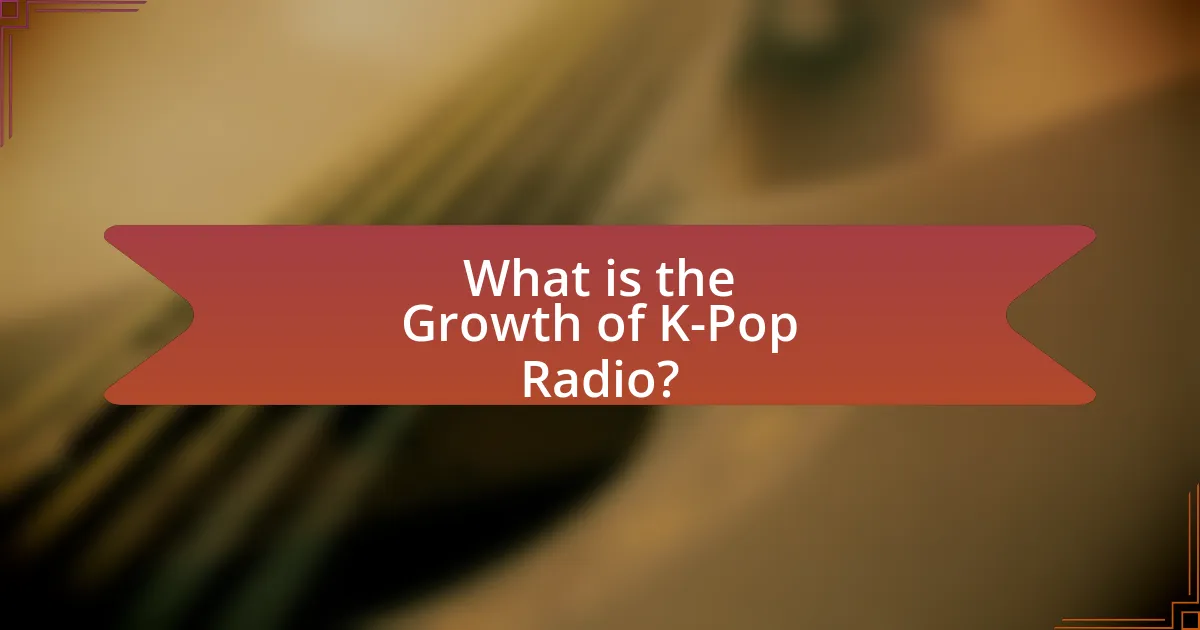
What is the Growth of K-Pop Radio?
The growth of K-Pop radio has been significant, driven by the global rise of K-Pop music and its increasing fanbase worldwide. As of 2023, K-Pop radio stations have expanded beyond South Korea, with numerous international stations dedicating airtime to K-Pop, reflecting its popularity in regions such as North America, Europe, and Southeast Asia. For instance, platforms like Spotify and Apple Music have reported a surge in K-Pop playlists and streams, indicating a growing demand for K-Pop content. Additionally, the establishment of dedicated K-Pop radio channels, such as K-Pop Radio in the U.S. and various online streaming services, has further contributed to this growth, allowing fans to access K-Pop music and related content more easily.
How has K-Pop radio evolved over the years?
K-Pop radio has evolved significantly over the years, transitioning from local broadcasts in South Korea to a global phenomenon accessible through various digital platforms. Initially, K-Pop music was primarily aired on terrestrial radio stations, which limited its reach to domestic audiences. However, with the advent of the internet and streaming services, K-Pop radio expanded its audience internationally, allowing fans worldwide to access K-Pop content.
The rise of platforms like Spotify, Apple Music, and dedicated K-Pop radio apps has facilitated this evolution, enabling listeners to enjoy curated playlists and live broadcasts from South Korean stations. Additionally, social media platforms have played a crucial role in promoting K-Pop radio, with artists and labels using these channels to engage with fans and share music. This shift has resulted in a significant increase in K-Pop’s global fanbase, with the genre achieving unprecedented popularity in markets such as the United States and Europe.
The evolution of K-Pop radio reflects broader trends in media consumption, where digital accessibility and global connectivity have transformed how music is shared and experienced.
What key milestones mark the development of K-Pop radio?
Key milestones in the development of K-Pop radio include the launch of dedicated K-Pop radio stations, the integration of K-Pop into mainstream radio playlists, and the rise of online streaming platforms. The first dedicated K-Pop radio station, KBS Cool FM, began broadcasting in 1991, significantly contributing to the genre’s popularity. In the 2000s, major radio networks like SBS and MBC started incorporating K-Pop into their programming, further expanding its reach. The advent of online streaming services such as Melon and Spotify in the 2010s allowed for global access to K-Pop music, enhancing its international presence and listener base. These milestones collectively illustrate the evolution and global impact of K-Pop radio.
How have technological advancements influenced K-Pop radio growth?
Technological advancements have significantly influenced K-Pop radio growth by enhancing accessibility and engagement through digital platforms. The rise of streaming services like Spotify and Apple Music has allowed K-Pop radio stations to reach global audiences, increasing listener numbers and expanding fan bases beyond South Korea. Additionally, social media platforms such as YouTube and TikTok have facilitated the viral spread of K-Pop songs, driving traffic to radio stations that feature these tracks. According to a report by the Korea Creative Content Agency, K-Pop’s global market share increased from 3.5% in 2017 to 8.2% in 2020, highlighting the impact of these technological tools on radio growth.
Why is K-Pop radio gaining global popularity?
K-Pop radio is gaining global popularity due to its unique blend of catchy music, high production values, and engaging visuals that resonate with diverse audiences. The genre’s ability to incorporate various musical styles, such as hip-hop, R&B, and electronic dance music, attracts listeners from different cultural backgrounds. Additionally, the rise of social media platforms and streaming services has facilitated easy access to K-Pop content, allowing fans worldwide to connect with artists and each other. The global success of K-Pop groups, exemplified by BTS and BLACKPINK, has further fueled interest in K-Pop radio, as these artists consistently break records and dominate charts internationally.
What factors contribute to the international appeal of K-Pop radio?
The international appeal of K-Pop radio is primarily driven by its catchy music, high production quality, and the global reach of social media platforms. K-Pop songs often feature infectious melodies and diverse genres, making them accessible and enjoyable to a wide audience. The production quality is typically high, with elaborate music videos and choreography that enhance the listening experience. Additionally, social media platforms like YouTube and TikTok facilitate the rapid spread of K-Pop content, allowing fans worldwide to engage with artists and their music. This combination of engaging music, visual appeal, and effective use of digital platforms has significantly contributed to the global popularity of K-Pop radio.
How do cultural exchanges impact K-Pop radio’s reach?
Cultural exchanges significantly enhance K-Pop radio’s reach by facilitating the sharing of music, language, and cultural elements across borders. These exchanges allow K-Pop to penetrate diverse markets, as evidenced by the increasing number of international collaborations and features with artists from various countries, which broaden the genre’s appeal. For instance, the collaboration between BTS and American artist Halsey on the song “Boy With Luv” not only topped charts globally but also introduced K-Pop to a wider audience, demonstrating how cultural exchanges can amplify radio play and listener engagement. Furthermore, platforms like Spotify and YouTube have enabled K-Pop radio stations to reach global audiences, with K-Pop playlists gaining millions of followers worldwide, underscoring the impact of cultural exchanges on the genre’s international presence.
What role do social media and streaming platforms play in K-Pop radio’s growth?
Social media and streaming platforms are crucial in driving the growth of K-Pop radio by enhancing accessibility and engagement. These platforms allow fans to discover, share, and promote K-Pop music globally, significantly increasing its reach. For instance, platforms like Spotify and Apple Music provide curated playlists and algorithm-driven recommendations that introduce listeners to new K-Pop artists and tracks, contributing to a surge in streaming numbers. Additionally, social media platforms such as Twitter, Instagram, and TikTok facilitate fan interactions and viral trends, which amplify the visibility of K-Pop songs and artists. According to a report by the Korea Creative Content Agency, K-Pop’s global market size reached approximately $5 billion in 2020, largely fueled by the digital presence on these platforms. This interconnected ecosystem of social media and streaming services not only promotes K-Pop music but also fosters a dedicated global fanbase, further propelling the growth of K-Pop radio.
How do platforms like Spotify and YouTube support K-Pop radio?
Platforms like Spotify and YouTube support K-Pop radio by providing extensive music libraries, personalized playlists, and promotional tools that enhance the visibility of K-Pop artists. Spotify offers curated playlists such as “K-Pop Daebak,” which feature popular tracks and emerging artists, driving listener engagement and discovery. YouTube, with its vast user base, allows K-Pop music videos to reach millions, facilitating viral trends and fan interactions through comments and shares. Additionally, both platforms utilize algorithms to recommend K-Pop content based on user preferences, further expanding the genre’s audience. This synergy between music streaming and video platforms has significantly contributed to the global popularity of K-Pop radio.
What is the significance of social media in promoting K-Pop radio?
Social media is crucial in promoting K-Pop radio as it facilitates direct engagement between artists, fans, and radio stations. Platforms like Twitter, Instagram, and TikTok allow for real-time interaction, enabling fans to share content, participate in challenges, and promote radio shows. This engagement leads to increased visibility and listener numbers; for instance, K-Pop groups often use social media to announce radio appearances, which can result in spikes in audience ratings. Additionally, social media analytics show that K-Pop-related hashtags frequently trend globally, demonstrating the genre’s widespread appeal and the effectiveness of social media in reaching diverse audiences.
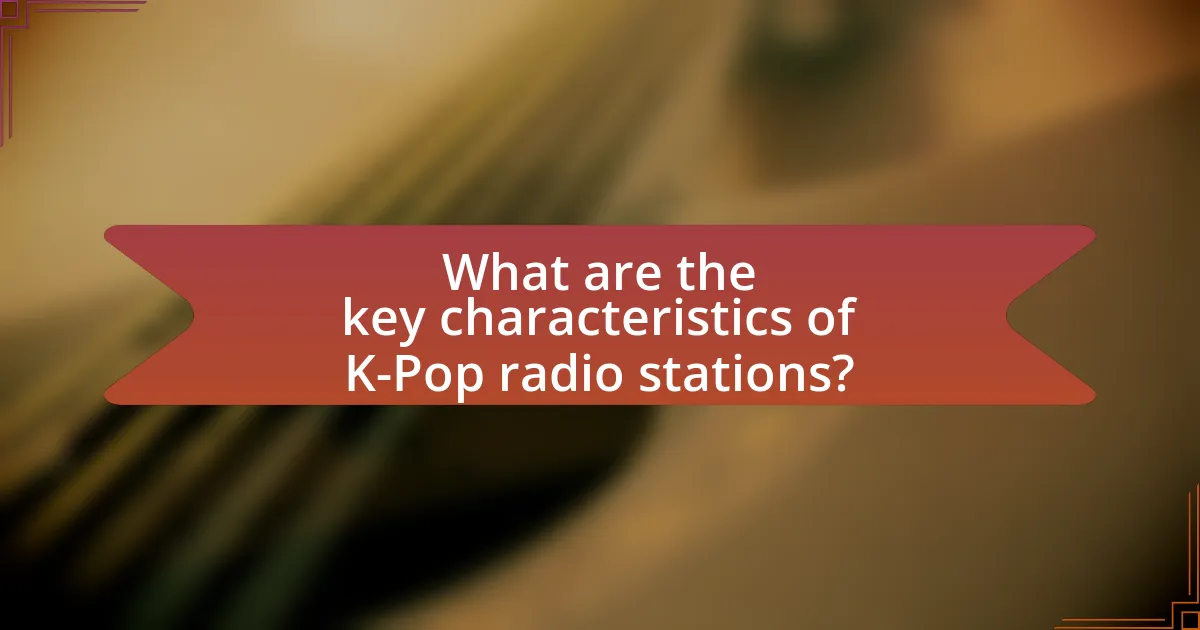
What are the key characteristics of K-Pop radio stations?
K-Pop radio stations are characterized by their focus on contemporary Korean pop music, diverse programming, and strong engagement with listeners. These stations primarily feature K-Pop tracks, often including both mainstream hits and emerging artists, which reflects the genre’s dynamic nature. Additionally, K-Pop radio stations frequently incorporate interactive segments, such as listener requests and live chats, fostering a community atmosphere among fans. They also provide content related to K-Pop culture, including interviews with artists, music charts, and news updates, which enhances listener engagement and keeps audiences informed about the latest trends. The global reach of K-Pop radio stations is evident as they often broadcast in multiple languages, catering to international fans and contributing to the genre’s worldwide popularity.
How do K-Pop radio stations differ from traditional radio stations?
K-Pop radio stations differ from traditional radio stations primarily in their focus on a specific genre and cultural context. K-Pop radio stations exclusively play Korean pop music, often featuring a mix of idol groups, solo artists, and related genres, while traditional radio stations typically offer a broader range of music genres, including rock, pop, country, and classical. Additionally, K-Pop radio stations engage with their audience through interactive platforms, utilizing social media and live streaming to connect with fans globally, which contrasts with the more conventional, one-way communication style of traditional radio. This genre-specific programming and audience engagement strategy reflect the unique cultural phenomenon of K-Pop, which has seen significant global growth, evidenced by the rise of K-Pop groups like BTS and BLACKPINK, who have achieved international chart success and massive fanbases.
What unique programming styles are found in K-Pop radio?
K-Pop radio features unique programming styles that include a blend of music, talk segments, and interactive listener engagement. These stations often incorporate a mix of K-Pop hits, interviews with artists, and themed shows that focus on specific genres or concepts, creating a dynamic listening experience. Additionally, K-Pop radio frequently utilizes social media platforms for real-time audience interaction, allowing listeners to request songs and participate in discussions, which enhances community involvement. This approach not only promotes the artists but also fosters a loyal listener base, contributing to the global growth of K-Pop culture.
How do K-Pop radio stations engage with their audience?
K-Pop radio stations engage with their audience through interactive programming, social media integration, and live events. These stations often host listener call-ins, allowing fans to request songs and share their thoughts, which fosters a sense of community. Additionally, they utilize platforms like Instagram and Twitter to promote contests, share behind-the-scenes content, and encourage fan participation, enhancing listener engagement. For instance, many K-Pop radio shows feature segments where listeners can send in messages or dedications, creating a personalized experience that resonates with fans. This approach not only strengthens the connection between the station and its audience but also contributes to the overall popularity and growth of K-Pop culture globally.
What types of content are typically featured on K-Pop radio?
K-Pop radio typically features music tracks from various K-Pop artists, including both popular hits and new releases. In addition to music, K-Pop radio often includes artist interviews, behind-the-scenes stories, and discussions about upcoming events or album releases. These elements are designed to engage listeners and provide insights into the K-Pop industry, enhancing the overall listening experience.
What genres and artists dominate K-Pop radio playlists?
K-Pop radio playlists are predominantly dominated by genres such as pop, hip-hop, and R&B. Artists like BTS, BLACKPINK, and EXO consistently feature at the top of these playlists, reflecting their widespread popularity and commercial success. For instance, BTS has achieved multiple Billboard Hot 100 number-one hits, while BLACKPINK’s tracks have garnered billions of views on platforms like YouTube, indicating their strong presence in K-Pop radio.
How do K-Pop radio stations incorporate interviews and live performances?
K-Pop radio stations incorporate interviews and live performances by featuring artists in both formats to enhance listener engagement and promote new music. These stations often schedule interviews with K-Pop idols to discuss their latest projects, allowing fans to gain insights into the artists’ thoughts and experiences. Additionally, live performances are frequently broadcasted, showcasing artists performing their hits in real-time, which creates a dynamic listening experience. For example, major K-Pop radio stations like KBS and SBS regularly host live sessions where popular groups perform, attracting large audiences and fostering a deeper connection between the artists and their fans. This combination of interviews and live performances not only boosts the stations’ popularity but also contributes to the overall growth of the K-Pop genre on a global scale.
What challenges do K-Pop radio stations face in the global market?
K-Pop radio stations face significant challenges in the global market, primarily due to cultural differences and competition from established music genres. Cultural barriers can hinder the acceptance of K-Pop among diverse audiences, as listeners may prefer local music styles over foreign genres. Additionally, K-Pop radio stations compete with mainstream radio and streaming platforms that dominate the market, making it difficult to attract a substantial listener base. According to a report by the International Federation of the Phonographic Industry, global music streaming is heavily influenced by local preferences, which can limit the reach of K-Pop content. Furthermore, licensing issues and copyright regulations in various countries complicate the distribution of K-Pop music, adding another layer of difficulty for these stations.
How do licensing and copyright issues affect K-Pop radio?
Licensing and copyright issues significantly impact K-Pop radio by determining which songs can be legally played and how royalties are distributed. These regulations require radio stations to obtain licenses from copyright holders, such as music labels and artists, to avoid legal repercussions. For instance, in South Korea, the Korea Music Copyright Association manages these licenses, ensuring that artists receive compensation for their work. Failure to comply with licensing agreements can lead to fines or shutdowns of radio stations, thereby affecting their programming and the availability of K-Pop music to listeners.
What competition do K-Pop radio stations encounter from other music genres?
K-Pop radio stations face significant competition from various music genres, including pop, hip-hop, rock, and electronic dance music (EDM). These genres attract diverse audiences, often leading listeners to prefer mainstream Western music over K-Pop. For instance, the global popularity of artists like Taylor Swift and Drake in pop and hip-hop creates a substantial challenge for K-Pop stations to retain listeners. Additionally, the rise of streaming platforms allows users to access a wide range of music, further intensifying competition as listeners can easily switch between genres. This dynamic landscape necessitates K-Pop radio stations to innovate and adapt their programming to maintain relevance in a crowded market.

How is the future of K-Pop radio shaping up?
The future of K-Pop radio is increasingly focused on global expansion and digital integration. As K-Pop continues to gain international popularity, radio stations are adapting by incorporating more diverse playlists that feature both established and emerging K-Pop artists. This shift is supported by the rise of streaming platforms, which allow for greater accessibility to K-Pop music worldwide. According to a report by the Korea Creative Content Agency, K-Pop’s global market share has grown significantly, indicating a strong demand for K-Pop content across various media, including radio. Additionally, collaborations between K-Pop artists and international musicians are becoming more common, further enhancing the genre’s reach and appeal on radio platforms.
What trends are emerging in K-Pop radio?
Emerging trends in K-Pop radio include the integration of diverse genres, increased international collaborations, and the use of digital platforms for broader reach. K-Pop radio stations are increasingly blending traditional pop with elements of hip-hop, R&B, and electronic music, reflecting the genre’s evolution and appeal to a wider audience. Additionally, collaborations between K-Pop artists and international musicians are becoming more common, enhancing global interest and listenership. The rise of streaming services and social media platforms has also transformed how K-Pop radio is consumed, allowing fans worldwide to access content easily and interact with artists in real-time. These trends indicate a significant shift towards a more inclusive and globally connected K-Pop radio landscape.
How is the integration of AI and technology influencing K-Pop radio?
The integration of AI and technology is significantly transforming K-Pop radio by enhancing personalization and content delivery. AI algorithms analyze listener preferences and behaviors, allowing radio stations to curate playlists that resonate with individual tastes, thereby increasing listener engagement. For instance, platforms like Melon and Genie utilize machine learning to recommend songs based on user history, which has been shown to boost user retention rates. Additionally, technology enables real-time interaction through social media and mobile apps, allowing fans to engage with their favorite artists and participate in live broadcasts, further solidifying the connection between K-Pop and its global audience.
What potential collaborations could enhance K-Pop radio’s growth?
Collaborations between K-Pop radio stations and global streaming platforms could significantly enhance K-Pop radio’s growth. By partnering with platforms like Spotify or Apple Music, K-Pop radio can reach a wider audience, leveraging the platforms’ extensive user bases and algorithms that promote music discovery. For instance, Spotify’s global reach, with over 400 million users, allows for targeted marketing and playlist placements that can introduce K-Pop to new listeners. Additionally, collaborations with international artists for exclusive interviews or live sessions can attract diverse audiences and create cross-promotional opportunities, further expanding K-Pop’s global footprint.
What strategies can K-Pop radio stations adopt for continued success?
K-Pop radio stations can adopt strategies such as diversifying content, engaging with listeners through social media, and collaborating with artists for exclusive interviews and performances to ensure continued success. Diversifying content allows stations to cater to various audience preferences, including different genres and cultural elements, which can attract a broader listener base. Engaging with listeners through social media platforms enhances interaction and builds a community around the station, fostering loyalty. Collaborating with artists not only provides unique content but also leverages the artists’ fan bases, increasing listenership. These strategies are supported by the growing global popularity of K-Pop, evidenced by the genre’s significant streaming numbers and social media engagement, which highlight the importance of innovative approaches in maintaining relevance in a competitive market.
How can K-Pop radio stations leverage audience feedback for improvement?
K-Pop radio stations can leverage audience feedback for improvement by actively soliciting listener opinions through surveys, social media interactions, and on-air call-ins. This direct engagement allows stations to understand listener preferences, such as favorite songs, desired content types, and overall satisfaction levels. For instance, a study by the Korean Broadcasting System found that stations that implemented listener feedback mechanisms saw a 30% increase in audience engagement and satisfaction. By analyzing this feedback, K-Pop radio stations can tailor their programming, enhance music selection, and create targeted promotions, ultimately fostering a more loyal listener base and driving growth in the competitive K-Pop landscape.
What marketing techniques can boost K-Pop radio’s visibility?
Utilizing social media marketing, collaborations with popular K-Pop artists, and targeted advertising can significantly boost K-Pop radio’s visibility. Social media platforms like Instagram, Twitter, and TikTok have proven effective for engaging fans and promoting content, as evidenced by the rapid growth of K-Pop fandoms online. Collaborating with K-Pop artists for exclusive interviews or live sessions can attract their fanbase, enhancing listener numbers. Additionally, targeted advertising on platforms frequented by K-Pop fans, such as YouTube and Spotify, can effectively reach the desired audience, as these platforms have millions of active users interested in K-Pop content.
What are the best practices for engaging with K-Pop radio audiences?
The best practices for engaging with K-Pop radio audiences include creating interactive content, leveraging social media platforms, and featuring exclusive artist interviews. Interactive content, such as polls and live Q&A sessions, fosters audience participation and strengthens community ties. Social media platforms like Twitter and Instagram are essential for real-time engagement, allowing fans to share their thoughts and connect with the radio station. Additionally, exclusive interviews with K-Pop artists provide unique insights that attract listeners, as fans are eager to hear directly from their favorite idols. These strategies are supported by the growing trend of K-Pop fandoms actively participating in radio discussions, as evidenced by the significant increase in social media interactions surrounding K-Pop radio shows.
How can K-Pop radio stations create interactive experiences for listeners?
K-Pop radio stations can create interactive experiences for listeners by incorporating real-time listener engagement through social media platforms, live call-ins, and interactive mobile applications. These methods allow listeners to participate in song requests, polls, and discussions, fostering a sense of community and involvement. For instance, stations can utilize platforms like Twitter and Instagram to conduct live Q&A sessions with artists, enabling fans to ask questions directly. Additionally, integrating features in mobile apps that allow listeners to vote for their favorite songs or participate in contests can enhance interactivity. This approach not only increases listener loyalty but also aligns with the interactive nature of K-Pop culture, where fan engagement is crucial.
What role does community building play in K-Pop radio success?
Community building is essential for K-Pop radio success as it fosters listener loyalty and engagement. By creating a sense of belonging among fans, radio stations can cultivate dedicated audiences who actively participate in discussions, share content, and promote the station. This engagement is evidenced by the rise of online fan communities and social media platforms where listeners interact, share experiences, and support their favorite artists, leading to increased listenership and higher ratings for K-Pop radio shows. For instance, platforms like Twitter and Discord have become hubs for fan interactions, significantly boosting the visibility and reach of K-Pop radio content.
